Accessible Bathtubs: An Amazing Diversity!
Engineers across the globe have put on their thinking caps and come up with an amazingly diverse array of bathtub solutions for individuals experiencing difficulty getting in and out of a standard bathtub. Thanks to the hard work of dozens of creative companies, the global market has been flooded with hundreds of different bathtub models across a range of different bathtub categories. The main differences in the bathtub categories can be found in the door type (no door, inward-opening, outward-opening, upwards-opening or sideways-opening door); the entry style (walk-in, slide-in or lift-in) and whether the user sits or lies down while they are inside the tub.
If you are seeking a more easily accessible bathtub, it is helpful to first understand what your options are. The information below provides a general overview of the types of accessible bathtubs that are available. We have highlighted a few of the pros and cons for each of the tub types listed below.
- Walk-in Bathtub – with “Inward Opening” Door
- A user must have the skills to walk fairly steadily, as necessary both to step in and out and to wiggle oneself around the inward-opening door once arriving inside.
- If a user’s physical strength declines further, the high tub wall permanently attached to the side of the seat can block a person from being able to access their tub at all.
- In the event of an emergency (I.e a heart attack), it is not possible to exit a tub with an inward opening door until the water has drained out.
- People can and have slipped down into the footwell of a tub with an inward-opening door and become trapped inside because their body prevented them from being able to open the door.
- Walk-in Cube Bathtub – with “Outward” Swinging Front Door
- The threshold is lower than a standard bathtub
- The door opens outward which makes it possible to exit pronto if there is a life-threatening emergency. The bathroom would be flooded with water, but this is clearly a secondary problem in a life-threatening situation.
- This type of bathtub requires a user to always have the skills to walk/step-in. It can be difficult or impossible to access by a wheelchair user who relies on a lateral-sliding transfer or by persons whose mobility skills are likely to decline with time, such as person’s with Parkinson’s disease or Multiple Sclerosis.
- This type of bathtub requires a user to always have the skills to step-in. It can be difficult or impossible to access by a wheelchair user who relies on a lateral-sliding transfer or by persons whose mobility skills are likely to decline with time (I.e. Parkinson’s disease, Multiple Scleorosis).
- Slide-in Style Bathtub – “Seated” Version with Outward Swinging Door
- It is possible to sit down on the seat before getting in. Once safely seated, each leg can be raised in one at a time. No “stepping in” required.
- A wheelchair user can perform a lateral-sliding transfer to the tub seat.
- Slide-in Style Bathtub – “Lying Down” Version with Outward Swinging Door
- The entire bathtub is placed at chair height so you merely need to sit down on the seat and then raise your legs one at a time into the bathtub – no “stepping in” required.
- It is accessible by persons who can walk and wheelchairs users.
- It is possible to lie down and submerge your upper back and shoulders.
- The toilet, vanity & other fixtures may impede the ability to open a long, outward swinging door.
- The door seal on bathtubs with outward swinging doors can sometimes leak over time and may need to be periodically replaced.
- Tub with Pull-up Style Door – “Seated Version”
- A user can sit down on the side of the seat first before getting in & then raise legs into the tub. No “stepping in” required
- It is accessible by persons who can walk and by wheelchairs users.
- If the electrical components fail while you are inside the tub, you may find yourself unable to get out.
- Mechanical components will require maintenance.
- Tub with Pull-up Style Door – “Lying Down version”
- The entire bathtub is placed at chair height so it is possible to sit down on the seat & simply raise your legs into the tub – no “stepping in” required.
- It is accessible by ambulatory users and those who use wheelchairs
- It is possible to lie down and submerge your upper back and shoulders.
- If a caregiver is involved, the increased height of the bathtub makes it easier for a caregiver to assist with bathing.
- Mechanical components will require maintenance.
- You may need to pay to install an additional drain, plumbing and/or electrical components.
- If the electrical components fail while you are inside the tub, you may find yourself unable to get out.
- Tub with Sliding Style Half-Door – “Lying Down version”
- The bottom of the bathtub is at chair height, so you can simply sit down and scoot backwards – no stepping in required
- The bottom compartment can be opened, allowing it to be used with a mechanical patient lift if needed
- It is accessible by ambulatory users and by wheelchair users.
- In the event a caregiver is involved, the increased height of the bathtub makes it easier to assist with bathing
- You must have enough upper body strength to be able to lift and scoot your bottom to the opposite end of the tub.
- For a caregiver, it may be difficult to reach over the half-door and help a person scoot to the back end of this type of bathtub. A hoyer-style mechanical lift can be purchased and used to assist with the transfers, if needed.
- Mechanical components will require maintenance
- Tub with Drop Down Side Panel [CURRENTLY OFF THE MARKET]
- The entire bathtub is at chair height so it is possible to sit down on the seat & simply raise legs into the tub – no “stepping in” required.
- It is accessible by ambulatory users and those who use wheelchairs
- It is possible to lie down versus sit upright
- In the event a caregiver is involved, the increased height of the bathtub makes it easier for them to assist with bathing
- You must have the physical skills to lean over, reach down and pull up the bathtub door once inside
- Your toilet, vanity or other fixtures may impede the ability to open/close the door.
- Mechanical components will require maintenance
- Bathtub with Drop Down Side Door that Becomes a Transfer Seat
- Eliminates the need to “step-in” to the bathtub
- Good for ambulatory or wheelchair users
- Tub height makes it easier for a caregiver to assist, if needed
- You must have the physical skills to close the door once inside
- You must have the arm strength to lift and scoot your bottom over the door and into the tub
- Mechanical components will require maintenance
- Bathtub with Mobile Seat
- No stepping in required. The seat lifts, turns & lowers you into the bottom of the tub
- The seat can be independently operated (no caregiver required)
- It can be used by ambulatory persons, a person who uses a wheelchair or in conjunction with a hoyer-style lift if needed
- Mechanical components will require maintenance
- If the electrical components fail while you are inside the tub, you may find yourself unable to get out independently.
- Bathtub with Swivel Seat & Side Opening Door
- Eliminates the need to step-in to the bathtub
- Accessible by ambulatory users & wheelchair users
- Bathtub with Extended Ledge
- Step-in Bathtub – with Low, Inward Opening Door
- It is necessary to have balance skills to bend down and open/close the door
- This solution helps you safely transfer into the tub for a shower, but does not help you to get up/down from the bottom of the tub for a bath
- Step-in Bathtub with Door and Molded Plastic Power Seat
- Lower threshold than a standard tub
- Power seat does the work to assist you to the bottom of the tub and lift you back up again
- You must be able to lean forward to open the low door
- Requires that you always have the skills to be able to “step”-in
- Does not allow for a lateral-sliding transfer from a wheelchair seat onto the seat inside.
- Step-in Bathtub with Door and Belt-Style Power Seat
- Lower threshold than a standard tub
- Power seat does the work to assist you to the bottom of the tub and lift you back up again
- The belt is not a sturdy seat to sit down on & stand up from making it less safe for those with limited mobility
- Requires that you always have the skills to be able to “step”-in
- Not accessible by someone using a wheelchair
- Walk in Shower & Tub Combined
- Relative to a Curb-less Accessible Shower, it still requires you to step over a several inch threshold
- It does not help you to get up and down from the bottom of the bathtub
- Swing Bathtub with Door
- Eliminates the need to “step-in”. You can sit on the seat and safely swing your legs over into the tub.
- Accessible by people who can walk, those using wheelchairs or those who rely on a hoyer-style lift
- Once seated the entire tub tilts back so you can be fully submerged
- Accessible on all sides by a caregiver
- Tall individuals may have difficulty bending knees enough for legs to clear the door when entering
- Mechanical components will require maintenance
- Shower Bathing Trolley
- Can be used by all people, from those who are completely independent, to those who require total care for bathing needs
- The entire bathtub’s height can be raised and lowered
- The soft, padded interior surface height can be increased & decreased for a more shallow or deeper bath
- A hoyer-style lift (shown in the picture) can be used with it for safely assisting someone who is more physically dependent with transfers
- Mechanical parts will need maintenance
- The bathtub trolley is longer than a standard bathtub, so it will only fit in a very large bathroom
- Swivel Tub: Prototype Only
 |
|
| Pros: |
|
| Cons: |
|
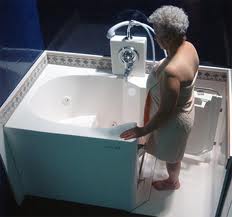 |
|
| Pros: |
|
| Cons: |
|
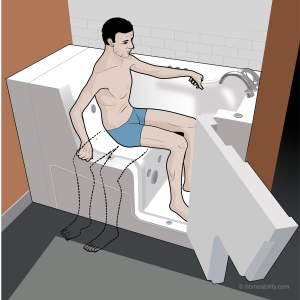 |
|
| Pros: |
|
| Cons: |
|
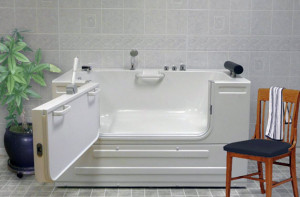 |
|
| Pros: |
|
| Cons: |
|
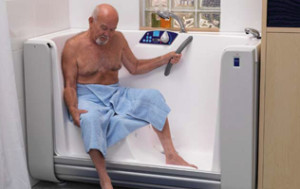 |
|
| Pros: |
|
| Cons: |
|
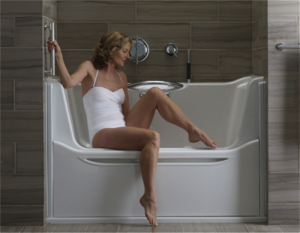 |
|
| Pros: |
|
| Cons: |
|
 |
|
| Pros: |
|
| Cons: |
|
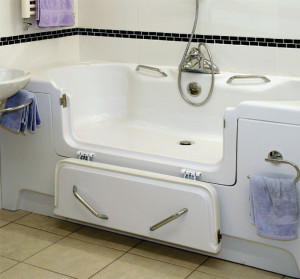 |
|
| Pros: |
|
| Cons: |
|
 |
|
| Pros: |
|
| Cons: |
|
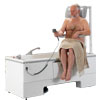 |
|
| Pros: |
|
| Cons: |
|
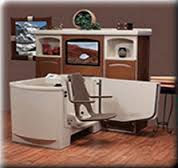 |
|
| Pros: |
|
| Cons: |
|
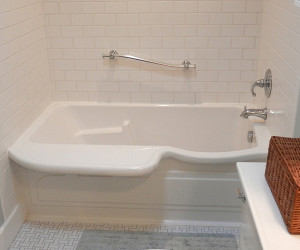 |
|
| Pros: |
|
| Cons: |
|
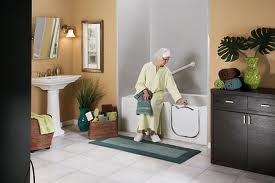 |
|
| Pros: |
|
| Cons: |
|
 |
|
| Pros: |
|
| Cons: |
|
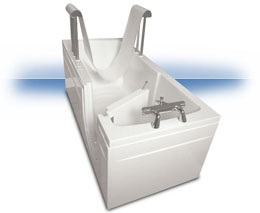 |
|
| Pros: |
|
| Cons: |
|
 |
|
| Pros: |
|
| Cons: |
|
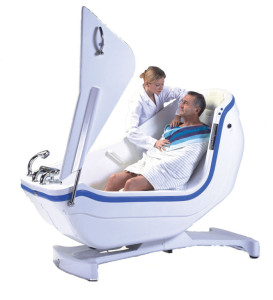 |
|
| Pros: |
|
| Cons: |
|
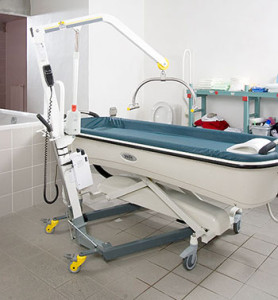 |
|
| Pros: |
The bathtub trolley has wheels so it can be used in a bedroom if needed |
| Cons: |
|
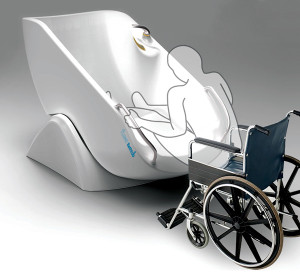 |
|
All of the bathtub solutions above involve replacing your old tub with a new one. Keep in mind that this means you will need to pay to have your existing tub removed and also pay to purchase and have the new tub installed. Other costs may include plumbing and electrical work, new paint, tiles or finish work around the new tub in order to make it blend seamlessly into the space where the old one resided.
If your intent for wanting to replace the bathtub is simply to be able to get in and out more easily, and you are not interested in (or are willing to waive) soaking in the bathtub, then you might consider having your own bathtub cut to make it more accessible (see picture below). For this you will need to hire a contractor experienced in doing “tub cuts” to cut a lower threshold entrance in the side of your existing bathtub. If you have a family member who does not want to give up the luxury of soaking in a warm bath, you can additionally add an insert with a door, which will make it possible for other family members to use the bathtub for soaking. If you do opt to add a door insert, the contractor will need to cut your tub to match the exact dimensions of one of the door insert solutions available on the market.
- Modify Your Own Tub (Tub Cut)
- Smaller threshold to step over.
- Much cheaper than paying to have your old bathtub removed & buying & installing a new one.
- Effectively turns your bathtub into a walk-in shower stall.
- There will still be a threshold to step over.
- “Soaking” in the bathtub is not possible unless a door insert is added (see below).
- Modify Your Own Tub – Tub Cut with Tub Door Insert
- If someone in your family still wants to use the tub for soaking, the door insert allows the tub to be used as a regular bathtub.
- The remaining threshold is usually higher if a door insert is installed.
- The door opens inwards into the bathtub. If you have a tub chair occupying the back end of the tub you could find it difficult to get your legs out of the way of the door to swing it closed. If there is nobody in your home who wants to use the bathtub for soaking, we recommend to forego purchasing and installing a door insert, as it is even safer and simpler to step in without the door insert present.
- Beginner’s Guide to Accessible Bathrooms
- Curbless Showers – A Great Age-Proof Bathing Solution!
- Buying a Walk-in Tub – Your Biggest Mistake?
- Your Own Home vs. Assisted Living: Cost Comparison
- The Truth About Home Modification Funding
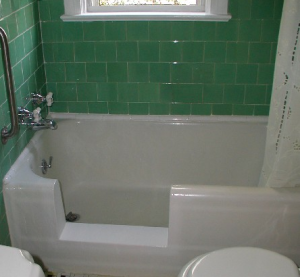 |
|
| Pros: |
|
| Cons: |
|
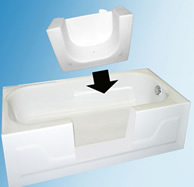 |
|
| Pros: |
|
| Cons: |
|
For more information on Tub Cuts, visit the Tub Cut Guide. To learn about other equipment solutions that can help make it easier and safer to bathe, but do not require you to replace your existing bathtub Click Here.
Bathtub Equipment on Amazon.com
More Topics You May Be Interested In:

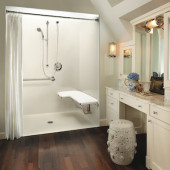



I confess I did not read Ms. Bonecutter`s comments before my own comment .I was so taken with the notion that finally what I really wanted was now available so I wonder why you would put the information out on the web for folks to see but cant have. If there is a manufacturer out there who are they and how do I get in touch with them. I await your response..Thank you. No offense but in the next day or so would be great.
Hi Ken,
Thanks for visiting the Homeability website. As you are aware, it is a free informational site & we do not sell any products. The initial articles posted are intended to raise people’s awareness about the general “types” of solutions that are possible and to help educate people about the key benefits and drawbacks so they can narrow it down to the general type of solution that will work best. Lists of manufacturers have not yet been included for each of the general types of solutions, but will be in the future, as we delve deeper into examining each of the general product types, and the variety of models and manufacturers behind them in future articles. In the mean time, I will be happy to personally send you some information to help you get started.
Best regards,
The Homeability Team
Being in a wheelchair limits my mobility to some degree. I do not walk or stand on my own but have no trouble transferring. My issue is the room (space) I have in the bathroom. The wall mounted motor has some degree of concern should it impede others from using the tub. I do like the wall mount as opposed to a model I saw once with the motor on the outside of the tub which would not be suitable because of the wheelchair.There is no video which is a disappointment, however I still wish to see some literature. If you have a site where the unit is better shown that also would be a plus.
My wife and I are in the planning phase of our bathroom remodel. We would like to install a soaker/laydown tub where the present, 60″ X 30″ tub is located. The bathroom is small so our requirements are: Inward swinging door on the left, drain on the right, no seat, no jets.
What company should we contact to purchase this style tub?
Hello. Thanks for visiting Homeability.
This is a free informational blog. Our goal is to help increase people’s awareness about the types of options that are available on the market and their respective pros and cons so people will be more informed when making decisions about which equipment is right for them. We don’t sell equipment or have the specs sheets for the manufacturers who do.
We do look forward to teaming up with a group which will allow us to present more of the product specs and fine-tuned details in the near future. If you would like to be alerted when this becomes available, please sign up for the homeability newsletter: https://homeability.com/subscribe-free/
Best regards,
The Homeability Team
I assume that I can buy longer shower curtains for the cut out tub without door.
Yes. Shower curtains can be found in stores and online in many different lengths including up to as much as 96″ long, if necessary.